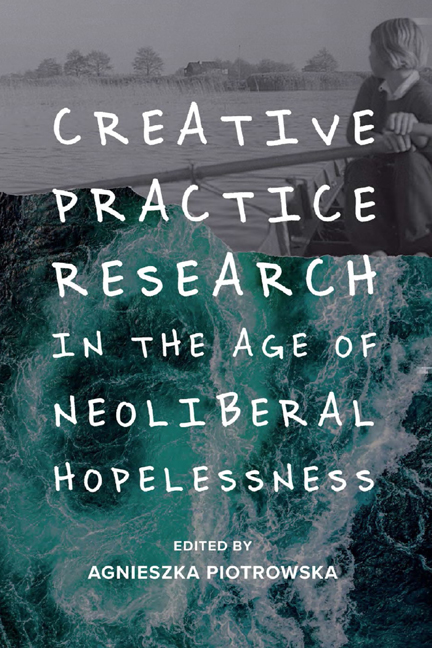Book contents
- Frontmatter
- Contents
- List of Figures
- Notes on Contributors
- Acknowledgements
- Preface: Life in the Post Pandemic Age
- Dedication
- 1 Introduction: Complexities, Compromises and Complicities
- 2 Against the Grain: Women Film Practitioners and Theorists Talk Creative Practice and Theory
- 3 Married to the Eiffel Tower: Notes on Love, Loss and Knowledge
- 4 Creativity and Neoliberalism: Between Autonomy, Resistance and Tactical Compliance
- 5 Tactical Compliance and the Persistence of Elsaesser
- 6 Storytelling and Game Playing
- 7 Autonomy and the Other Woman: Queer Active Agency and Postcolonial Expectations
- 8 From Neolithic to Neoliberal
- 9 First-person Expression on ‘Non-Western’ Screens: China as a Case Study
- 10 Scholarly Exploration of the Creative Process: Integrating Film Theory and Practice
- 11 Teaching Practice as Theory: Guerrilla Filmmaking
- 12 Baits of Falsehood: The Role of Fiction in Documentary or From Untheorised Practice to Unpractised Theory
- 13 Repented: A Creative Intersemiotic Translation
- Notes on Repented
- 14 How do you see me? The Camera as Transitional Object in Diasporic, Domestic Ethnography
- 15 ‘Shut Your Hole, Girlie. Mine's Making Money, Doll’: Creative Practice-Research and the Problem of Professionalism
- 16 Feminist ‘Pensive-creative Praxis’ and Irigaray: A Porous, Dialogical Encounter
- 17 The Paths of Creation, or How Can I Help my Dybbouk to Get Out of Me?
- 18 ‘We Want to Kill Boko Haram’: Reflections on the Photographic Representation of Children in a Displacement Camp
- 19 Between ‘Counter-movement’ (Ingold) and ‘Living with Ghosts’ (Demos)
- 20 Screen Memories: A Video Essay on Smultronstället/Wild Strawberries
- Index
18 - ‘We Want to Kill Boko Haram’: Reflections on the Photographic Representation of Children in a Displacement Camp
Published online by Cambridge University Press: 17 October 2020
- Frontmatter
- Contents
- List of Figures
- Notes on Contributors
- Acknowledgements
- Preface: Life in the Post Pandemic Age
- Dedication
- 1 Introduction: Complexities, Compromises and Complicities
- 2 Against the Grain: Women Film Practitioners and Theorists Talk Creative Practice and Theory
- 3 Married to the Eiffel Tower: Notes on Love, Loss and Knowledge
- 4 Creativity and Neoliberalism: Between Autonomy, Resistance and Tactical Compliance
- 5 Tactical Compliance and the Persistence of Elsaesser
- 6 Storytelling and Game Playing
- 7 Autonomy and the Other Woman: Queer Active Agency and Postcolonial Expectations
- 8 From Neolithic to Neoliberal
- 9 First-person Expression on ‘Non-Western’ Screens: China as a Case Study
- 10 Scholarly Exploration of the Creative Process: Integrating Film Theory and Practice
- 11 Teaching Practice as Theory: Guerrilla Filmmaking
- 12 Baits of Falsehood: The Role of Fiction in Documentary or From Untheorised Practice to Unpractised Theory
- 13 Repented: A Creative Intersemiotic Translation
- Notes on Repented
- 14 How do you see me? The Camera as Transitional Object in Diasporic, Domestic Ethnography
- 15 ‘Shut Your Hole, Girlie. Mine's Making Money, Doll’: Creative Practice-Research and the Problem of Professionalism
- 16 Feminist ‘Pensive-creative Praxis’ and Irigaray: A Porous, Dialogical Encounter
- 17 The Paths of Creation, or How Can I Help my Dybbouk to Get Out of Me?
- 18 ‘We Want to Kill Boko Haram’: Reflections on the Photographic Representation of Children in a Displacement Camp
- 19 Between ‘Counter-movement’ (Ingold) and ‘Living with Ghosts’ (Demos)
- 20 Screen Memories: A Video Essay on Smultronstället/Wild Strawberries
- Index
Summary
This chapter reflects on my visual ethnography and participatory photography practice in the context of displacement. It is a scholarly exploration of my creative process in photographically constructing children living at the Internally Displaced Persons (IDP) Camp in Durumi, Abuja, Nigeria's capital; and the contemporary photographers from whose representational practices I have drawn inspiration. Additionally, I reflect on my practice as a form of advocacy and on humanitarian photography as a subset of the documentary photography form.
BACKGROUND
Seventh in the world's most populous nations ranking (around 198 million people), Nigeria also has an estimated ‘1.7 million IDPs in over 321,580 households across six states of northeast Nigeria with 40 per cent residing in camp-like settings in urban areas plus 1.4 million returnees’ (Vanguard 2018). The majority of these people were displaced following the insurgency by the Boko Haram terrorist group in northern Nigeria. According to the Global Terrorism Index (GTI), the West African nation is the third country most impacted by terrorism globally, though the number of people killed in 2018 reduced by 5,950/80 per cent compared to the peak of terrorist deaths in 2014 (Institute of Economics and Peace 2018).
Boko Haram, whose ideology is predicated upon anti-Western education, has abducted hundreds of schoolgirls and killed thousands of people (Delman 2015). Okoli and Iortyer (2014: 44–5) cite public insecurity, livelihood crisis, humanitarian abuses, population displacement and refugee debacle, and human casualty/fatality as the humanitarian consequences of the Boko Haram insurgency. ‘The plight of these displaced people in their various places of refuge can be best described as critically threatening’ (p. 45), having been dislodged from their families, social capital bases, and thrown into a serious humanitarian crisis. I have therefore produced a documentary photography project, which focuses on the survivors, particularly the children living in the Durumi displacement camp, adopting visual ethnography and participatory photography (photovoice) methods. The objective of the project was to create a counter-narrative to the normative form of media representation of distant suffering.
Most of everyday news and images of Africa in the global media are thematically narrow and negative, focusing disproportionately on violence, war, famine and disease (Scott 2017: 40-41, Schwittay 2015: 7).
- Type
- Chapter
- Information
- Creative Practice Research in the Age of Neoliberal Hopelessness , pp. 271 - 287Publisher: Edinburgh University PressPrint publication year: 2020



